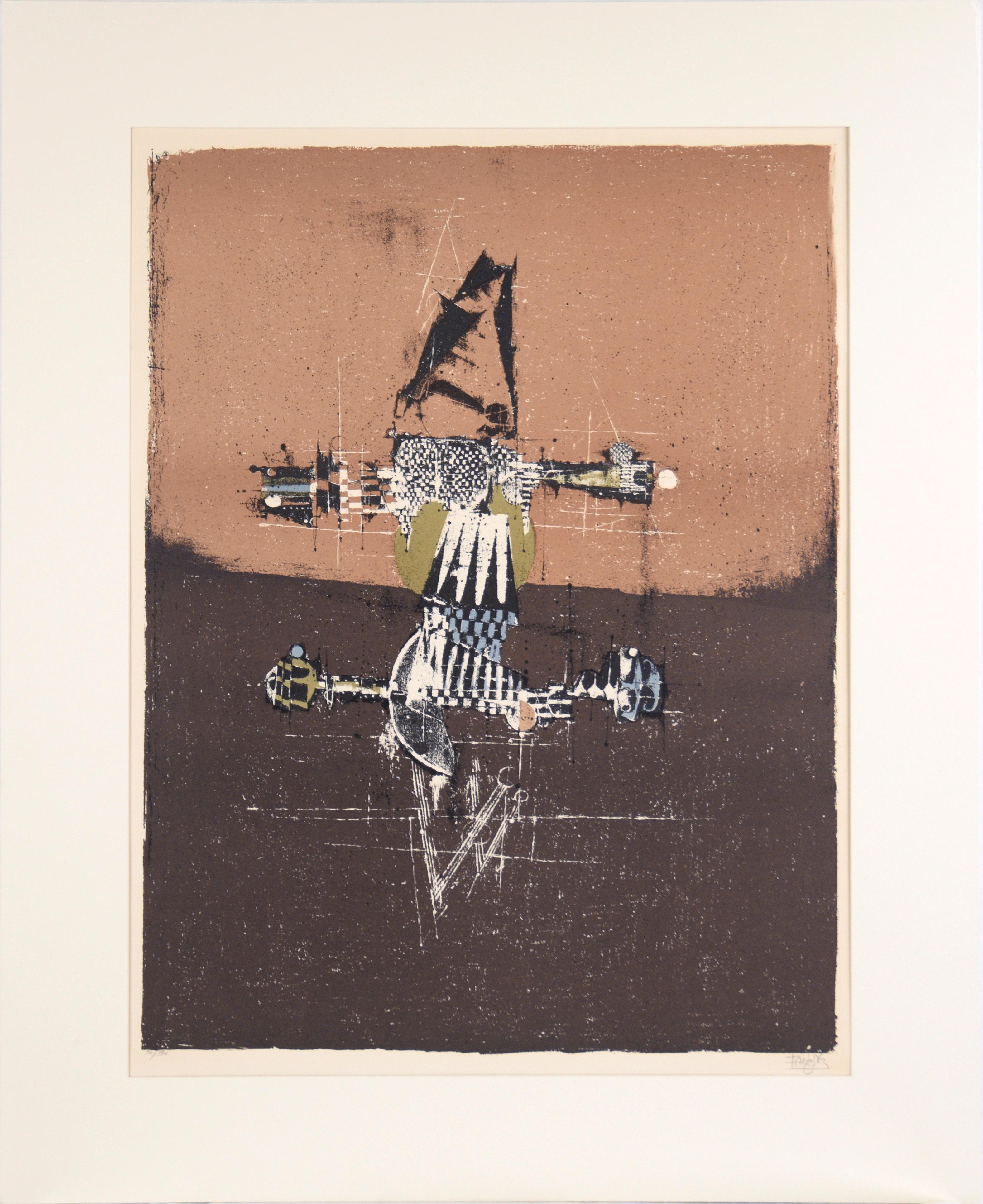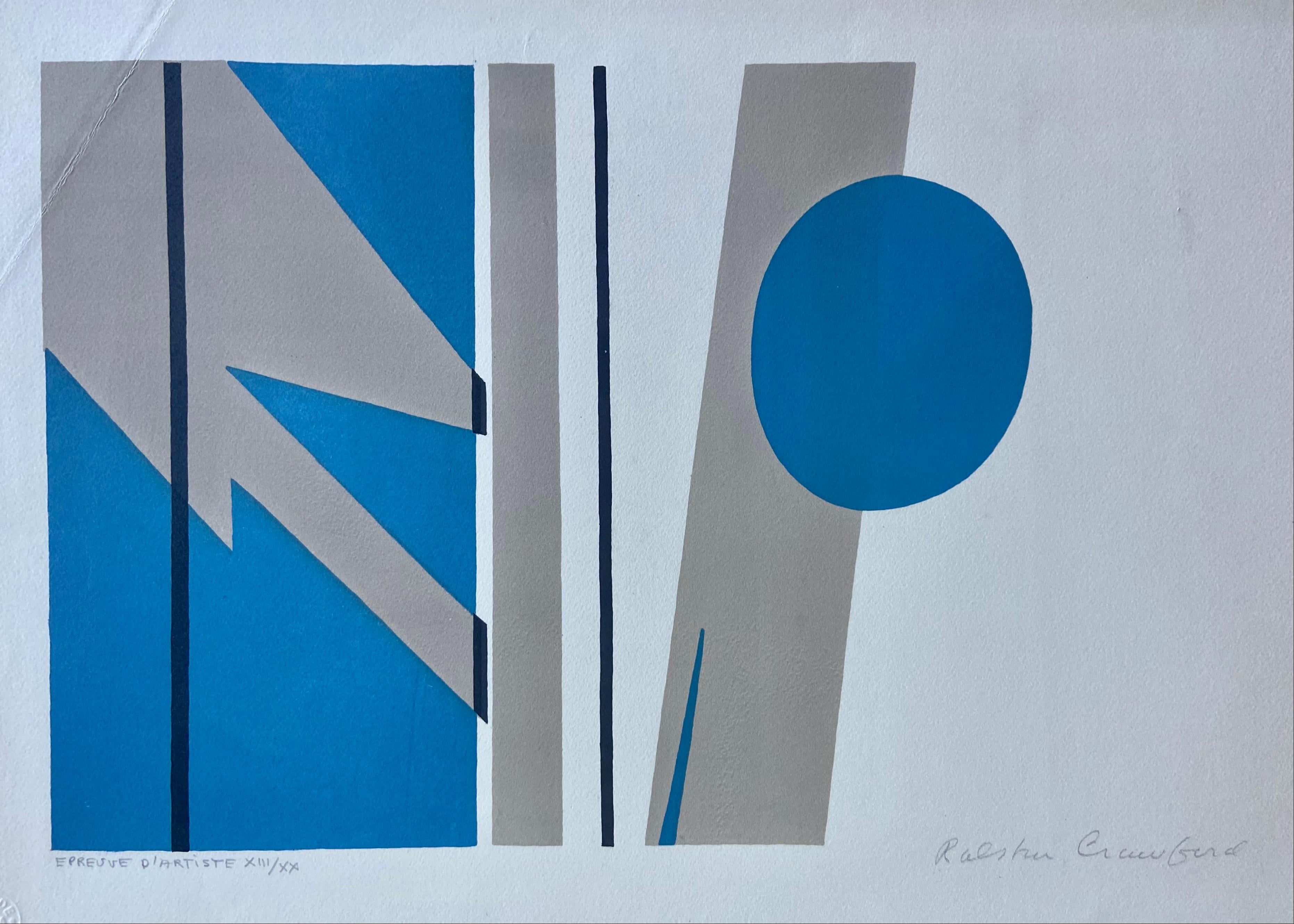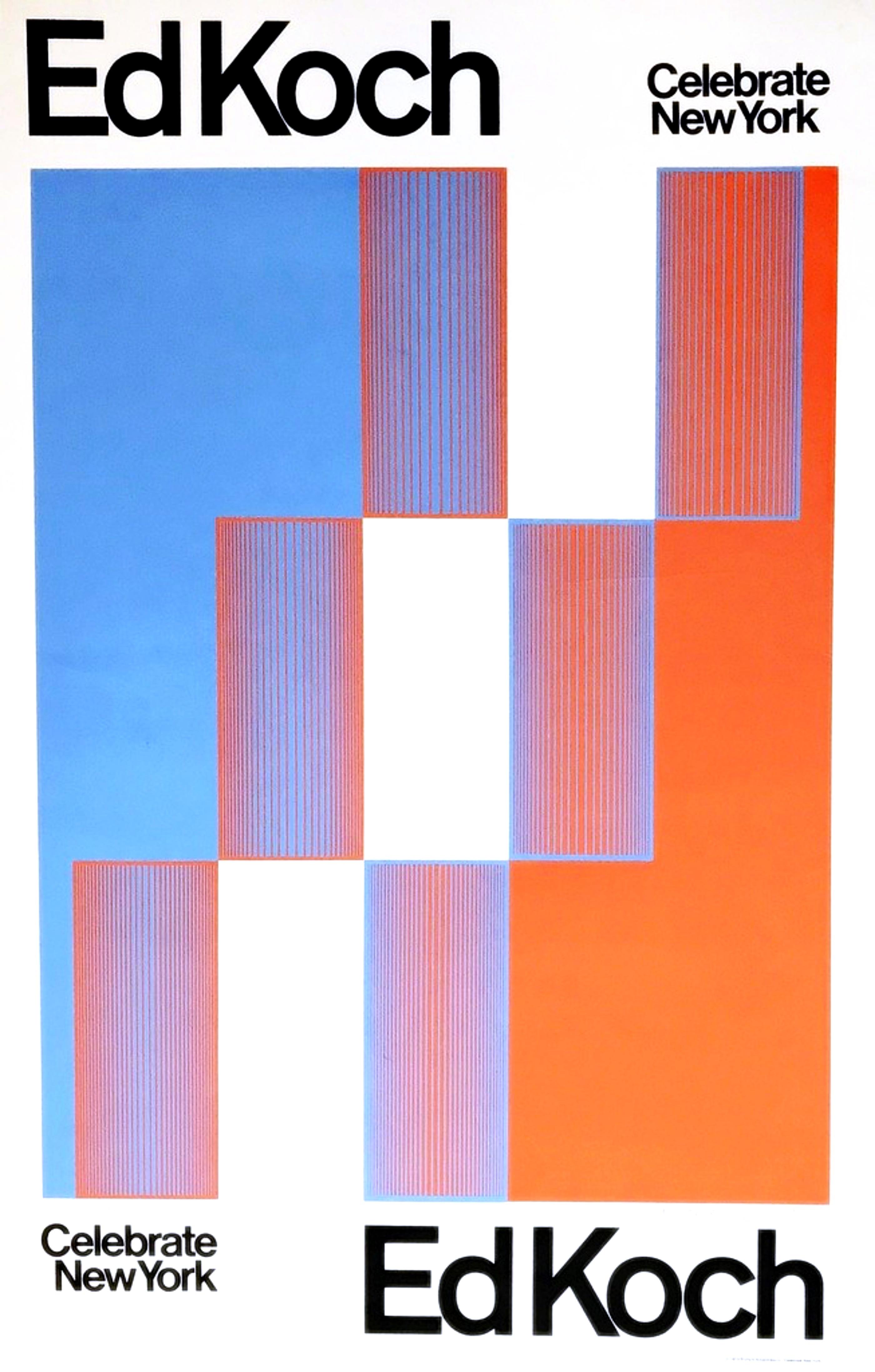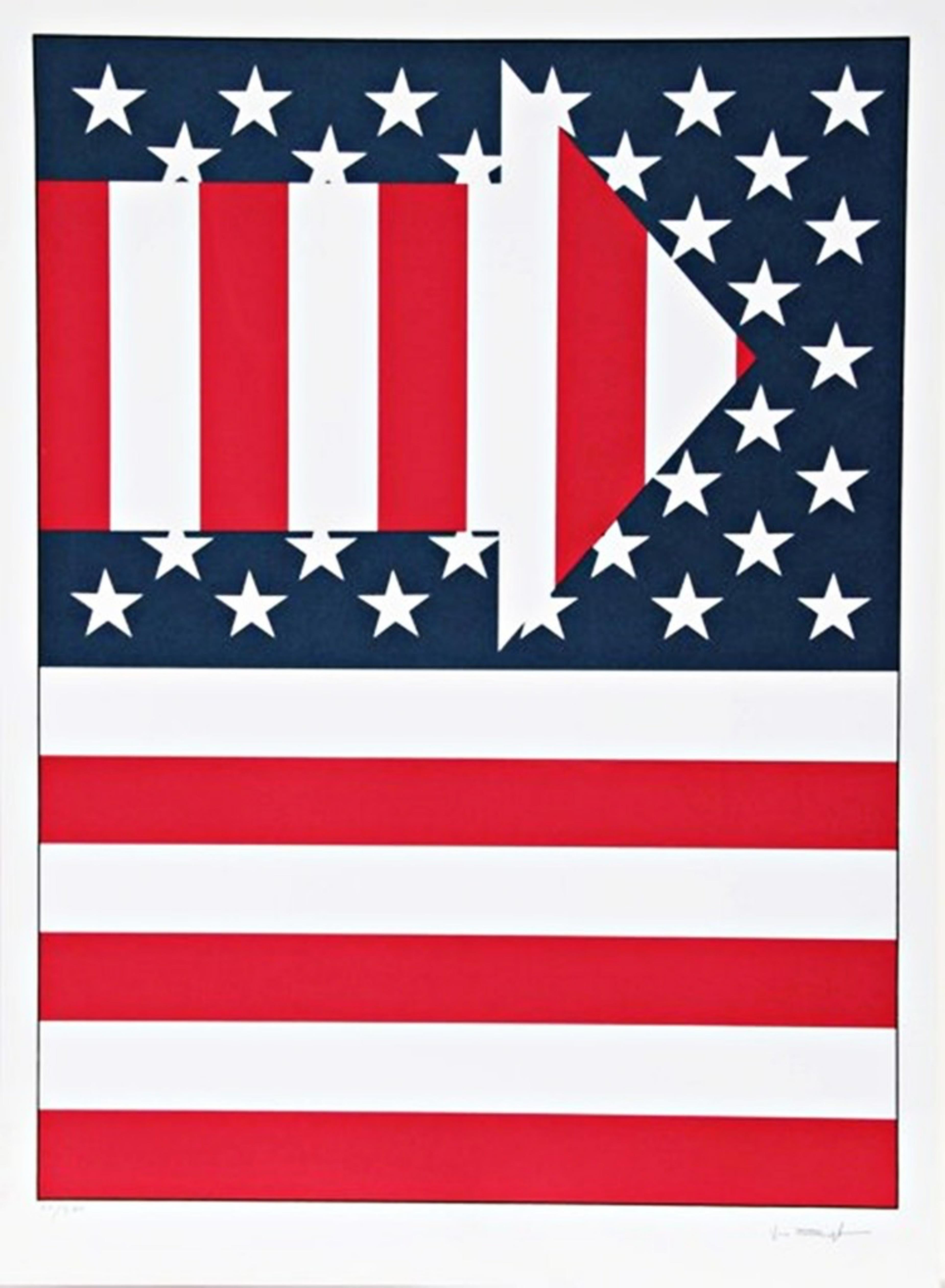Items Similar to Living Painting - Colour Pochoir
Want more images or videos?
Request additional images or videos from the seller
1 of 5
(after) Sonia DelaunayLiving Painting - Colour Pochoir1969
1969
About the Item
after Sonia Delaunay
Full-page, colour pochoir after costume designs by Sonia Delaunay
Edition 331/500 copies on Velin Aussedat
Dimensions: 28.5 x 19.5 cm.
From 27 Living Paintings. [Milano, Edizioni del Naviglio, 1969]. Jacques Damase. Robes Poèmes, Introduction. Text by Guillaume Apollinaire and Blaise Cendrars.
Sonia Delaunay was known for her vivid use of color and her bold, abstract patterns, breaking down traditional distinctions between the fine and applied arts as an artist, designer and printmaker.
Born Sarah Stern on November 14, 1885 in Gradizhsk, Ukraine, she was adopted in 1890 by her maternal uncle, Henri Terk, a lawyer in St. Petersburg, where she grew up, exposed to music and art, and learning several foreign languages. In 1903, she moved to Germany to study drawing with Ludwig Schmidt-Reutler (1863–1909) at the Karlsruhe academy of fine arts; Arnold Schoenberg (1874–1951), composer-to-be, was among her classmates there. In 1905, she traveled to Paris where she attended art classes at the Académie de la Palette, learned printmaking from Rudolf Grossman (1889–1941), and met Amédée Ozenfant (1886–1966), André Dunoyer de Segonzac (1884–1974), and Jean-Louis Boussingault (1883–1943). Sonia spent much of her time at exhibitions and galleries in Paris, which showed works by Paul Cézanne, Vincent Van Gogh, Pierre Bonnard, and Edouard Vuillard, as well as Les Fauves, Henri Matisse and André Derain. She did, however, maintain contact with Germany, exhibiting at the Galerie Der Sturm, Berlin, in 1913, 1920 and 1921.
During her first year in Paris, Sonia met the German collector and art-dealer, Wilhelm Uhde (1874–1947), whom she married on December 5, 1908, and whose Montparnasse gallery, the Galerie Notre-Dame des Champs, showed her first solo exhibition. Through Uhde, Sonia encountered many painters, including Pablo Picasso, Georges Braque, Maurice de Vlaminck, and Robert Delaunay (1885–1941). In 1910, Sonia divorced Uhde by mutual agreement, married Delaunay that same year, and gave birth to their son, Charles, in January 1911.
Together Sonia and Robert Delaunay pursued the study of color, influenced by theories of Michel-Eugène Chevreul (1786–1889). Sonia’s interest in simultaneous contrast, as evidenced in her early collages, book bindings, small painted boxes, cushions, waistcoats and lampshades, led to one of her first large-scale works, the painting of the Bal Bullier (1912–1913), a popular Parisian dance-hall. Sonia’s first “simultaneous dresses,” a mix of squares and triangles of taffeta, tulle, flannelette, moiré, and corded silk, date from this period.
Friendship with the poet Blaise Cendrars (1887–1961) resulted in Sonia’s colored-squares fabric binding for his poem Pâques à New York (1912), and her collaboration on an accordion-type book of Cendrars’ long 207 verse poem, La Prose du Transsibérien et de la Petite Jehanne de France (1913), whose unique format, a vertical scroll almost two meters long, is said to have been inspired by the Delaunays’ fascination with the Eiffel Tower. Other aspects of modern urban life that inspired Sonia’s work included electric street lights (Prismes électriques, 1914) and publicity, though the various studies that she did for projects for Chocolat, Zenith, and Le Rêve gas stoves all remained unrealized.
When World War I was declared in 1914, Sonia Delaunay was in the Basque border town of Fuenterrabía with her husband, and they did not return to Paris until 1920. During this period, they traveled to Madrid and to the village of Vila do Condo in Portugal, and Valença da Minho, where she painted still-lifes and market scenes. While in Madrid, she had become interested in Flamenco singers, and continued to do versions of this subject in Portugal (Flamenco Singer, 1916). Sonia Delaunay claimed that living in the Iberian Peninsula had opened her eyes to the very origin of light.
Settled in Madrid, she started to engage in interior decoration (Casa Sonia) in addition to designing clothes and costumes. In 1918, Serge Diaghilev (1872–1929) commissioned her to do the costumes for a Ballets Russes production of Cléopatre, which opened in London. The soprano Aga Lahovska persuaded Delaunay to design the costumes for a production of the opera Aida at the Liceo in Barcelona. Following the Aida, she was invited to decorate a new nightclub, the Petit Casino, scheduled to open in a remodeled theatre in Madrid. She virtually gave up painting between 1918 and 1935 when she lost the financial support of her relatives in St. Petersburg with the outbreak of the Russian Revolution in 1917.
When Sonia and Robert Delaunay returned to Paris in 1920, they took an apartment at 19 boulevard Malesherbes, which Sonia completely redecorated with furniture that she designed herself—most pieces now in the Musée des Arts Décoratifs in Paris. The Delaunay home was open to members of Dada and Surrealist groups: Tristan Tzara (1896–1963), Philippe Soupault (1897–1990), André Breton (1896–1982), Louis Aragon (1897–1982), René Crevel (1900–1935), etc. Delaunay’s friendship with Tzara lasted more than forty years: they launched the famous ‘poem-dresses’ (words and colors in ever new relationships through body movement), and in July 1923 Delaunay designed the costumes for Tzara’s play, Coeur à gaz, which was produced as part of an evening of experimental theatre, with music by Georges Auric (1899–1983), and Crevel in one of the parts.
Delaunay’s involvement in fabrics began as early as 1923 with the more than fifty designs that she provided a silk manufacturer in Lyon. In 1924, she founded her own company with four directors, among them the prominent couturier and furrier, Jacques Heim (1899–1967). Her greatest success came in 1925, at the Exposition Internationale des Arts Décoratifs et Industriels Modernes, for which she designed and decorated her Boutique Simultanée, run with the help of Heim.
Sonia Delaunay was extraordinarily prolific up to the 1930 world Depression; her work became known in London at Liberty’s and in department stores in New York, not to mention her profitable collaboration with the Amsterdam department store of Metz & Co., begun in 1925. She was designing not only fabrics and fashion, but carpets and panels and handbags, and also costumes for two films: Vertige, directed by Marcel L’Herbier (1888–1979), and Le p’tit Parigot by René Le Somptier (both 1926). Her renown for her fabrics and clothing brought her an invitation to speak at the Sorbonne, January 27, 1927, on “The Influence of Painting on the Art of Clothing,” where she introduced the revolutionary idea of prêt-à-porter (ready-to-wear).
During the 1930s, Sonia Delaunay’s life was divided between fashion design, articles in magazines, interior decorating, and projects for window displays and posters. In 1937, the Exposition Internationale des Arts et Techniques dans la Vie Moderne, backed by Léon Blum’s (1872–1950) Popular Front government, solicited the participation of the Delaunays in the decoration of two temporary exhibition buildings: the Pavillon des Chemins de Fer and the Palais de l’Air. Voyages lointains and Portugal, which Sonia painted for the railroad pavilion, were awarded a gold medal.
The Delaunays were ardent promoters of abstract art: they became members of the Abstraction-Création group in 1931 and organized the first Salon des Réalités Nouvelles in 1939. After her husband’s death in 1941, Sonia continued her energetic support of abstract art, while reestablishing Robert’s reputation with a number of exhibitions of his work and bequests of his work and hers to public institutions. By the 1950s, Delaunay was beginning to exhibit her own work again, particularly in the gallery in Auteuil of Colette Allendy. In 1953 the Galerie Bing mounted a solo show, which brought her renewed attention, and she was also represented in exhibitions in Paris (Musée National d’Art Moderne and Galerie Suzanne Michel) and Rome. In 1955 the Rose Fried Gallery in New York gave her her first solo show in the United States. The following year she had exhibitions in Grenoble, Havana, Venice, Rome and Milan. In 1958 the Städtisches Kunsthaus in Bielefeld organized a large exhibition of her works, comprising some 260 pieces, and thereafter she participated regularly in exhibitions devoted to the work of the Moderns.
In 1964 Delaunay became the first living female artist to have a retrospective exhibition at the Louvre, thanks to her donation of 117 works by herself and Robert (Donation Delaunay). In March 1965 she sent a gouache and an oil to Salon des femmes peintres, a show exclusive to women painters. And in July 1965 she began collaboration with Jacques Damase (b. 1931) on a book of poems and pochoirs, using documents in her possession from Robert’s collection of poems by his friends. It appeared under the title Rhythmes-Couleurs, with a preface by Michel Hoog.
One of the first important exhibitions of Delaunay’s work, which took place in Paris in 1965 after her meeting Damase, was called ‘L’Expo 1925,’ at the Musée des Arts Décoratifs, where an entire room was devoted to her fabric designs and dresses. In 1967, with Damase’s help, she enjoyed what may have been her greatest tribute, a full-scale retrospective of her work, consisting of almost two hundred pieces, at the Musée National d’Art Moderne.
By the time Sonia Delaunay died at home in Paris on December 5, 1979, she had received the Légion d’honneur and painted the poster for the International Women’s Year of UNESCO (both 1975), collaborated in costume designs for a production at the Comédie-Française (Luigi Pirandello’s Six Characters in Search of an Author, 1978), and taken part in the Paris-Moscow Exhibition at the Centre Pompidou (1979), to which she had donated her entire graphic work in 1976. Her recognition as an artist was such that President Georges Pompidou (1911–1974), on an official visit to the United States, brought one of Sonia Delaunay’s paintings as a gift from the French governmen
- Creator:(after) Sonia Delaunay (French)
- Creation Year:1969
- Dimensions:Height: 11.23 in (28.5 cm)Width: 7.68 in (19.5 cm)Depth: 0.04 in (1 mm)
- Movement & Style:
- Period:
- Condition:
- Gallery Location:Collonge Bellerive, Geneve, CH
- Reference Number:1stDibs: LU16121805823
About the Seller
4.9
Gold Seller
These expertly vetted sellers are highly rated and consistently exceed customer expectations.
Established in 2015
1stDibs seller since 2015
908 sales on 1stDibs
Typical response time: 2 hours
- ShippingRetrieving quote...Ships From: Collonge Bellerive, Geneve, Switzerland
- Return PolicyA return for this item may be initiated within 7 days of delivery.
More From This SellerView All
- Henri Laurens - Ocean - Original Color Linoleum CutBy Henri LaurensLocated in Collonge Bellerive, Geneve, CHHenri Laurens - Ocean - Original Color Linoleum Cut 1938/1959 Medium : Color Linoleum Cut on Montgolfier Canson vellum Dimensions: 32 x 24 cm XXe siècle Henri Laurens was born in Paris in 1885. Impaired by tuberculosis when he was only 17, he is leg-amputated seven years later. First a stone cutter, he then becomes sculptor. In 1899, he studies drawing. Henry Laurens...Category
1930s Surrealist Abstract Prints
MaterialsEtching
- Pietro Consagra - Composition - Original EtchingBy Pietro ConsagraLocated in Collonge Bellerive, Geneve, CHPietro Consagra - Composition - Original Etching 1959 Dimensions: 32 x 24 cm From the art review XXe siècle Unsigned and unumbered as issuedCategory
1950s Surrealist Abstract Prints
MaterialsEtching
- Zoran Music (after) - Composition - PochoirLocated in Collonge Bellerive, Geneve, CHZoran Music (after)- Composition - Pochoir 1959 Dimensions: 32 x 24 cm From the art review XXe siècle Unsigned and unumbered as issuedCategory
1950s Surrealist Abstract Prints
MaterialsEtching
- after Jean Arp - Moustaches et Squelette - PochoirBy Jean ArpLocated in Collonge Bellerive, Geneve, CHafter Jean Arp Moustaches et Squelette Executed in 1957 after the original artwork by the studios from Daniel Jacomet in Paris, France Pochoir Dimensions: 32 x 24 cm From the art re...Category
1950s Surrealist Abstract Prints
MaterialsStencil, Paper
- Jean Arp - Original EtchingBy Jean ArpLocated in Collonge Bellerive, Geneve, CHJean Arp - Original Etching 1954 Dimensions: 32 x 24 cm From XXe siècle Unsigned and unumbered as issuedCategory
1950s Surrealist Abstract Prints
MaterialsEtching
- after Jean Arp - PochoirBy Jean ArpLocated in Collonge Bellerive, Geneve, CHafter Jean Arp - Pochoir 1957 Dimensions: 32 x 24 cm From the art review XXe siècle Unsigned and unumbered as issuedCategory
1950s Surrealist Abstract Prints
MaterialsStencil
You May Also Like
- "Haarlem" Aquatint Etching on PaperBy Johnny FriedlaenderLocated in Soquel, CABold abstract aquatint by Johnny Friedlaender (Polish-French, 1912-1992). Comprised of two main sections, this piece is full of detail and texture. The upper layer is a reddish tan, whereas the bottom layer is a rich brown. Geometrical shapes are arranged such that they almost form mirror images of each other, but vary enough to create interest and a sense of movement. Signed in the lower right corner. Numbered 56/350 in the lower left corner. Includes original certificate of authenticity. Presented in a new cream mat with foamcore backing. Mat size: 42"H x 32"W Paper size: 33.75"H x 24.5"W Johnny Friedlaender was a leading 20th century artist, whose works have been exhibited in Germany, France, Netherlands, Italy, Japan and the United States. He has been influential upon other notable artists, who were students in his Paris gallery. His preferred medium of aquatint etching is a technically difficult artistic process, of which Friedlaender has been a pioneer. Johnny Gotthard Friedlaender was born in Pless (Silesia) and his early studies were in Breslau under Otto Mueller. In 1936 Friedlaender journeyed to Czechoslovakia, Switzerland, Austria, France and Belgium. At the Hague he held a successful exhibition of etchings and watercolours. He fled to Paris in 1937 as a political refugee of the Nazi regime with his young wife, who was an actress. In that year he held an exhibition of his etchings which included the works: L 'Equipe and Matieres et Formes. From 1939 to 1943 he was interned in a series of concentration camps, but survived against poor odds. After freedom in 1944 Friedlaender began a series of twelve etchings entitled Images du Malheur with Sagile as his publisher. In the same year he received a commission to illustrate four books by Freres Tharaud of the French Academy. In 1945 he performed work for several newspapers including Cavalcade and Carrefour. In the year 1947, he produced the work Reves Cosmiques, and in that same year he became a member of the Salon de Mai, which position he held until 1969. In the year 1948 he began a friendship with the painter Nicolas de Stael and held his first exhibition in Copenhagen at Galerie Birch. The following year he showed for the first time in Galerie La Hune in Paris. After living in Paris for 13 years, Friedlaender became a French citizen in 1950. Friedlaender expanded his geographic scope in 1951, and exhibited in Tokyo in a modern art show. In the same year he was a participant in the XI Trienale in Milan, Italy. By 1953 he had produced works for a one-man show at the Museum of Neuchâtel and exhibited at the Galerie Moers in Amsterdam, the II Camino Gallery in Rome, in São Paulo, Brazil and in Paris. He was a participant of the French Italian Art Conference in Turin, Italy that same year. Friedlaender accepted an international art award in 1957, becoming the recipient of the Biennial Kakamura Prize in Tokyo. In 1959 he received a teaching post awarded by UNESCO at the Museum of Modern Art in Rio de Janeiro. By 1968, Friedlaender was travelling to Puerto Rico, New York and Washington, D.C. to hold exhibitions. That year he also purchased a home in the Burgundy region of France. 1971 was another year of diverse international travel including shows in Bern, Milan, Paris, Krefeld and again New York. In the latter city he exhibited paintings at the Far Gallery, a venue becoming well known for its patronage of important twentieth century artists. From his atelier in Paris Friedlaender instructed younger artists who themselves went on to become noteworthy, among them Arthur Luiz Piza, Brigitte Coudrain, Rene Carcan...Category
1970s Abstract Geometric Abstract Prints
MaterialsPaper, Etching, Aquatint
- S.S. De GrasseBy Ralston CrawfordLocated in Belgrade, MTOriginal Lithograph signed by the artist and numbered 156/200, and is a limited edition. Ralston Crawford was born in Saint Catherine's , Ontario in 1906. He came to the U.S. in 1910...Category
Mid-20th Century Abstract Geometric Abstract Prints
MaterialsLithograph
- Celebrate New York (hand signed limited edition poster)By Richard AnuszkiewiczLocated in New York, NYRichard Anuszkiewicz Celebrate New York (hand signed limited edition poster), 1974 Silkscreen on wove paper Hand-signed by artist, signed, dated and inscribed "to Lowell" on the fron...Category
1970s Abstract Geometric Abstract Prints
MaterialsScreen
- Duality Triumphant I (Mid Century Modern Geometric Abstraction)By Alfred JensenLocated in New York, NYAlfred Jensen Duality Triumphant I (Mid Century Modern Geometric Abstraction), 1963 Color Silkscreen on wove paper Pencil signed, dated, named and number 19/52 by Alfred Jensen on th...Category
Mid-20th Century Abstract Geometric Abstract Prints
MaterialsScreen
- Original Weltcup Slalom Damen vintage downhill ski posterBy Niklaus TroxlerLocated in Spokane, WAOriginal ski poster for the World Cup Slalom Damen (Women's) Feb/. 1987. Linen backed. Original vintage winter sport alpine ski event poster for the Women's Slalom World Cup 198...Category
1980s Abstract Geometric Figurative Prints
MaterialsOffset
- American Flag III (Geometric Abstraction Hard Edge Minimalist Abstraction) S/NBy Paul von RingelheimLocated in New York, NYPAUL VON RINGELHEIM American Flag III, 1979 Silkscreen in Colors on wove paper Signed and numbered in graphite pencil on the lower margin front 31 × 23 inches Unframed Hand signed and numbered from the limited edition of 300. Born in Vienna Austria, but working in the US for many decades, Von Ringelheim, also known as a sculptor, brought his unique hard-edge minimalistic geometric abstraction outsider's take on the American Flag to this vintage 1970s limited edition, signed silkscreen. Unframed and in fine condition. Ringelheim was represented in the 1960s by the legendary Rose Fried Gallery...Category
1970s Abstract Geometric Abstract Prints
MaterialsScreen
Recently Viewed
View AllMore Ways To Browse
Vintage Living Art
Vintage Living Room Colors
Living National
Vintage Inspired Living Room
Retro Inspired Living Room
Vintage Living Book
Parisian Living Room
Retro Living London
Tower Of Living
Living Posters
Apartment Vintage Living Room
B May Handbag
Retro Design Clothes
Geometric Print Fabric
Prism Color
Retro Window Displays
Retro Window Display
Geometric Handbag





